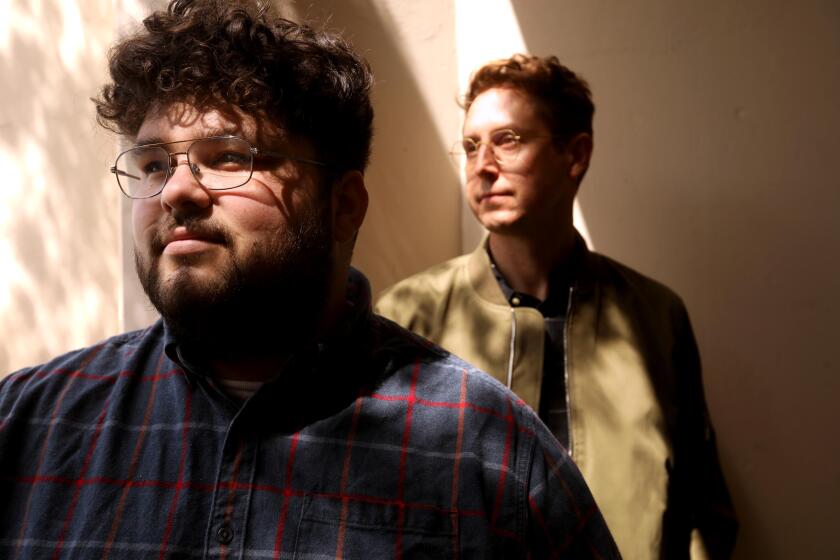Johnny Got His Gun, but Now He Can’t Get a Job
The GIs put their lives on the line far from home. Now some have returned to the unemployment line.
Several of the service members who came to a job fair in Culver City on Saturday are emblematic of a troubling problem: the unemployed, or underemployed, veteran.
At the National Guard armory, Diane Kehrlein steered her wheelchair through the rows of recruiting tables. An Army sergeant in the first Gulf War, and a reservist through 2000, Kehrlein was partially disabled while in the service. She is now a student looking for a good job.
“I can get up and walk,” said Kehrlein, smiling and upbeat. “I just can’t walk a long way.
Nearby, Dayon Dillihunt recalled repeated mortar attacks on his airbase in far northern Iraq before talking about his homecoming last year.
“I don’t believe veterans are treated like we should be treated,” said Dillihunt, 31. “I’m not saying we should be treated with a silver spoon, but we sacrificed. We have homeless vets at my age -- homeless vets.”
“A lot of younger kids leave home with no direction,” said Dillihunt, who joined the Army out of Venice High School and headed an intelligence squad in Kirkuk. “They feel a need to start somewhere. They enlist.”
He sees young men and women come home after a tour in Iraq, blow their accumulated pay, and then “reenlist, because they don’t have anything else.”
Dozens of recruiters packed the armory hall. Many police and fire departments were represented. Candidates for school police were being sought. At one table, a recruiter from the Getty Museum was looking for a few good security guards.
In California, close to 100,000 veterans are looking for work at any moment, said Kent Kjelstrom, a veterans representative with the California Employment Development Department. Those ranks have been swelled by returning veterans of Iraq and Afghanistan.
The newest job seekers seem to be having the most trouble, officials say.
“If you look at young veterans, under the age of 25, there is a higher unemployment rate than among young nonveterans,” said Sharon Cohany, an economist at the U.S. Department of Labor in Washington. And that puzzles observers.
For older groups, the difference disappears, and sometimes veterans even have the advantage, Cohany said. Most recent statistics show the younger veterans facing unemployment rates of 13% to 15%, compared with all others in their age group of 8% or 9%.
A number of factors can account for the difference. Cohany suggested that there are some military specialties “that just don’t have a civilian counterpart.” And several observers mentioned traits in the modern service member.
“They demand more from their employers, they are pickier than in past years. That’s the honest--to-God truth,” said Dr. Dennis D. Scott, head of the healthcare system for the U.S. Department of Veterans Affairs in Los Angeles, who attended the job fair.
“One veteran wanted to know if we had a place where he could chill out and go play computer games.”
Scott, a Vietnam vet, said one distinguishing characteristic of the modern veteran population is the presence of women.
In California in the last year, more than 29,000 service members left the military and turned to the state for help in finding jobs, more than a third of them veterans of Iraq and Afghanistan, Kjelstrom said. Only 734 have been reservists, in part because of job protections for reservists called to active duty.
About 550,000 reservists have been mobilized since 9/11. Job protections enacted after the first Gulf War seem to be effective for these veterans.
Kenneth Kinney, who joined a unit after attending Narbonne High School in Harbor City, was assigned to military police duties at the U.S. detention facility at Guantanamo Bay, Cuba.
Kinney, 31, remained in the guard as a recruiter after he returned from overseas duty last year. He said the soldiers he reenlists do so because “they miss the uniform, they miss structure -- not that they can’t find a job.”
Of the 30,000 men and women mustered out of the military in California every year, 47% stay in the state. Experts suggest that the state’s economy and job demand may be the reason.
Yet jobs are still needed. A Labor Department study concluded this month that California and New Jersey had the lowest percentage of veterans employed after they were enrolled in state placement programs.
Kinney, Dillihunt and others said veterans are often unaware of the services available to them, such as the event Saturday sponsored by the state Employment Development Department, which has dozens of offices throughout Southern California.
More to Read
Start your day right
Sign up for Essential California for news, features and recommendations from the L.A. Times and beyond in your inbox six days a week.
You may occasionally receive promotional content from the Los Angeles Times.





